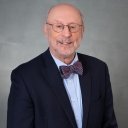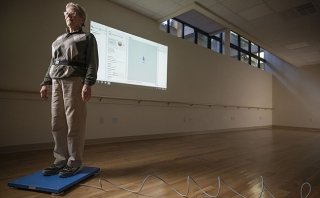New Study Finds that Age-Related Fat May Lead to Less Effective Muscle Function
Could lead to worse balance and possibly an increase in future falls
-

Senior Scientist
BOSTON – A new study published in the Journal of Clinical Endocrinology and Metabolism found that age-related accumulation of abdominal fat is associated with lower muscle density. Low muscle density means the muscle has more fat in it, which can lead to less effective muscle function that in turn may lead to more falls. According to the study, individuals with the greatest 6-year accumulation of visceral adipose tissue (VAT), found in the abdomen, had significantly lower muscle density. Since VAT accumulation is a preventable risk factor for poor musculoskeletal outcomes associated with aging, these findings add to the growing dangers of accumulating fat in the body.
Entitled “Accumulation in Visceral Adipose Tissue Over 6 Years Is Associated With Lower Paraspinal Muscle Density,” it is the first large, longitudinal study of the association between changes in VAT and muscle density.
“Most obesity research has focused on metabolic and cardiovascular outcomes such as diabetes, hyperlipidemia, hypertension, coronary heart disease, and osteoarthritis. But there is considerably less consensus on the role of obesity on the risk for low muscle mass or muscle density,” said Lead Author Ching-Ti Liu, Ph.D., Professor in the Department of Biostatistics at Boston University School of Public Health, and Senior Author Douglas P. Kiel, M.D., M.P.H., Director, Musculoskeletal Research Center and Senior Scientist, Hinda and Arthur Marcus Institute for Aging Research.
The study found that VAT may represent a modifiable risk factor for poor musculoskeletal outcomes with aging.
“The study adds important new information to public health efforts to reverse the trend of the growing obesity problem in the United States and worldwide,” the authors said. “Fat that accumulates in the abdomen sometimes referred to as the ‘male pattern,’ was shown to produce less dense muscle surrounding the spine, resulting in less-effective muscle function.”
The other researchers on the study were Timothy Tsai, M.P.H., Research Software Engineer II at the Hinda and Arthur Marcus Institute for Aging Research; Brett T. Allaire, Research Assistant III at the Center for Advanced Orthopedic Studies, Beth Israel Deaconess Medical Center; Mary L. Bouxsein, Ph.D., Professor of Orthopedic Surgery, Center for Advanced Orthopedic Studies, Beth Israel Deaconess Medical Center; Marian T. Hannan, D.Sc., M.P.H., Senior Scientist, Hinda and Arthur Marcus Institute for Aging Research; and Thomas G. Travison, Ph.D., Director of Biostatistics and Data Sciences, Co-Director of the Interventional Studies in Aging Center, Senior Scientist, Hinda and Arthur Marcus Institute for Aging Research.
The study was approved by Boston University Medical Campus and the Hebrew SeniorLife institutional review boards.
Funding came from a National Institutes of Health’s National Institute of Arthritis and Musculoskeletal and Skin Diseases (NIAMS) (R01 AR041398).
About Hebrew SeniorLife
Hebrew SeniorLife, an affiliate of Harvard Medical School, was founded in 1903 and today is a national leader dedicated to empowering seniors to live their best lives. Hebrew SeniorLife cares for more than 3,000 seniors a day across six campuses throughout Greater Boston. Locations include: Hebrew Rehabilitation Center-Boston and Hebrew Rehabilitation Center-NewBridge in Dedham; NewBridge on the Charles, Dedham; Orchard Cove, Canton; Simon C. Fireman Community, Randolph; Center Communities of Brookline; and Jack Satter House, Revere. Hebrew SeniorLife also trains more than 1,000 future health care professionals each year, and conducts influential research into aging at the Hinda and Arthur Marcus Institute for Aging Research, which has a robust research portfolio whose NIH funding in 2021 places it in the top 10% of NIH-funded institutions. For more information about Hebrew SeniorLife, visit our website or follow us on our blog, Facebook, Instagram, Twitter, and LinkedIn.
About the Hinda and Arthur Marcus Institute for Aging Research
Scientists at the Marcus Institute seek to transform the human experience of aging by conducting research that will ensure a life of health, dignity, and productivity into advanced age. The Marcus Institute carries out rigorous studies that discover the mechanisms of age-related disease and disability; lead to the prevention, treatment, and cure of disease; advance the standard of care for older people; and inform public decision-making.


